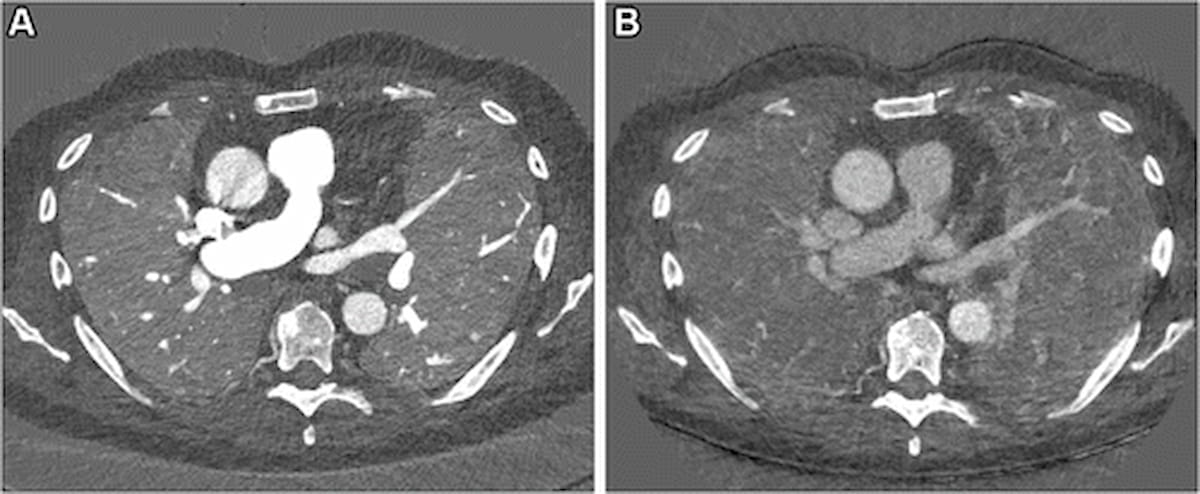Study Says Photon-Counting CT Offers Better Lung Assessment than Conventional CT
For conditions ranging from interstitial lung disease and post-COVID-19 complications to idiopathic pulmonary fibrosis, photon-counting computed tomography (PCCT) facilitates simultaneous functional and morphologic lung assessment at lower radiation dosing than conventional chest CT, according to newly published research.
Newly published research showed that a photon-counting computed tomography (PCCT) protocol for lung assessment had an 84.7 percent success rate in obtaining CT-derived parameters including perfusion, regional ventilation, late contrast enhancement and CT angiography.
For the retrospective study, recently published in Radiology, researchers utilized a PCCT protocol to assess 166 patients (mean age of 63.2 years) with impaired pulmonary function. The researchers sought to determine differences with lung volume, ventilation, perfusion, and late contrast enhancement in six subgroups of patients with conditions including unspecified interstitial lung disease, connective tissue disease, idiopathic pulmonary fibrosis (IPF), post-COVID-19 complications, chronic thromboembolic pulmonary hypertension, and other pulmonary pathology, according to the study.
In addition to the aforementioned success in obtaining CT-derived parameters through simultaneous morphologic and functional imaging, the researchers noted reduced radiation dosing with a mean CT dose index of 3.22 mGy for inspiration and 3.09 mGy for expiration.
“(This dosing) is below the mean total radiation dose of 8-12 mGy (diagnostic reference levels) that is recommended for a single chest CT scan by official regulatory organizations in multiple European countries,” wrote study co-author Hoen-oh Shin, M.D., who is affiliated with the Institute of Diagnostic and Interventional Radiology at Hannover Medical School and the German Center for Lung Research in Hannover, Germany, and colleagues.
One can see key differences in axial perfusion images obtained with photon-counting computed tomography (PCCT) (left) versus dual-energy CT (right) in a 67-year-old patient with idiopathic pulmonary fibrosis. (Images courtesy of Radiology.)

The study authors said the improved signal-to-noise ratio with PCCT was particularly beneficial in facilitating assessment of lung perfusion and ventilation.
“Using our proposed protocol, the visual analysis of the functional images was promising in providing insights into ventilation and perfusion physiologic structure. In patients with chronic thromboembolic pulmonary hypertension, spatially correlated ventilation and perfusion maps provided delineation of ventilation-perfusion mismatch, whereas CT angiography images allowed for analysis of intravascular thrombi,” pointed out Shin and colleagues.
In the subgroup analysis, patients with idiopathic pulmonary fibrosis (IPF) had the lowest lung volume inspiration (3415 mL) and expiration levels (1898 mL) as well as the lowest attenuation inspiration (-722 HU) and expiration (-556 HU). The researchers also found that the post-COVID-19 condition group had the highest lung perfusion (.14) and late contrast enhancement (.59) in the subgroup analysis.
“The higher demonstrated values of the post-COVID-19 condition group for perfusion and late contrast enhancement than other subgroups indicate that possibly persistent changes in the microcirculation play a role for functional impairment,” noted Shin and colleagues.
In regard to study limitations, the researchers conceded the technically demanding nature of registering inspiratory and expiratory lungs with large differences in lung volume was subject to errors, two-thirds of which were due to post-processing issues mainly caused by registration. Post-processing with the PCCT protocol also took an average of two hours to complete, according to the study authors.
What is the Best Use of AI in CT Lung Cancer Screening?
April 18th 2025In comparison to radiologist assessment, the use of AI to pre-screen patients with low-dose CT lung cancer screening provided a 12 percent reduction in mean interpretation time with a slight increase in specificity and a slight decrease in the recall rate, according to new research.
The Reading Room: Racial and Ethnic Minorities, Cancer Screenings, and COVID-19
November 3rd 2020In this podcast episode, Dr. Shalom Kalnicki, from Montefiore and Albert Einstein College of Medicine, discusses the disparities minority patients face with cancer screenings and what can be done to increase access during the pandemic.
Can CT-Based AI Radiomics Enhance Prediction of Recurrence-Free Survival for Non-Metastatic ccRCC?
April 14th 2025In comparison to a model based on clinicopathological risk factors, a CT radiomics-based machine learning model offered greater than a 10 percent higher AUC for predicting five-year recurrence-free survival in patients with non-metastatic clear cell renal cell carcinoma (ccRCC).
Could Lymph Node Distribution Patterns on CT Improve Staging for Colon Cancer?
April 11th 2025For patients with microsatellite instability-high colon cancer, distribution-based clinical lymph node staging (dCN) with computed tomography (CT) offered nearly double the accuracy rate of clinical lymph node staging in a recent study.